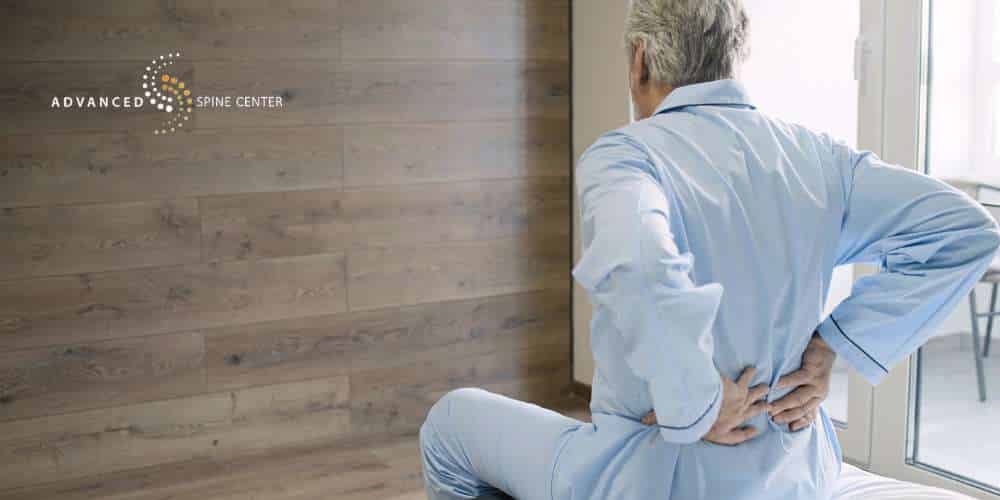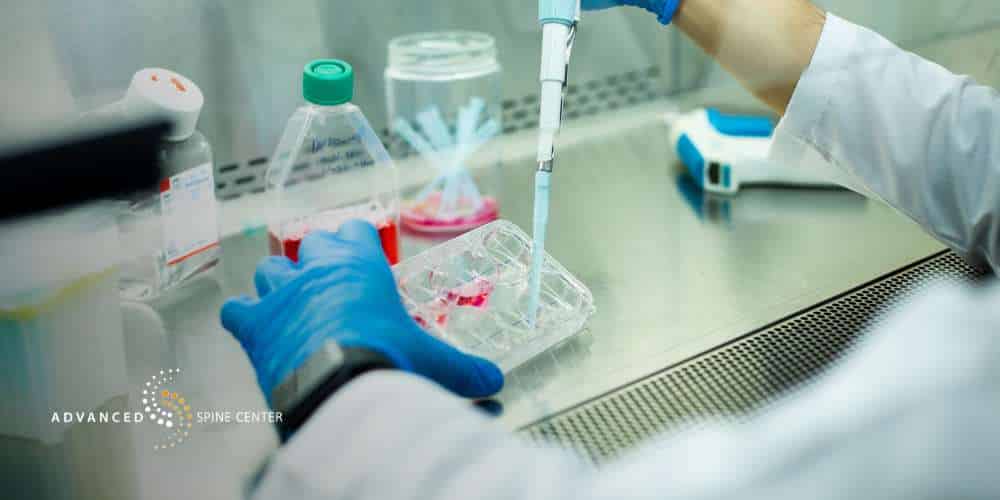Over the years, spinal stenosis has been treated using a variety of different therapies and procedures, but what is the newest treatment for spinal stenosis? Stem cell transfusions have proven effective at treating spinal stenosis, but there are a number of other treatments that can help improve the lives of individuals with spinal stenosis.
At Advanced Spine Center in Plano, TX, we stay at the forefront of medical advancements to ensure that our patients have access to the latest and most effective treatments available. If you’re struggling with symptoms of spinal stenosis and seeking a solution that goes beyond traditional treatments, contact Plano orthopedic specialist Stephen P. Courtney, MD today.
Call (972) 499-5457 today and schedule an appointment with Dr. Courtney to discuss your options.
What Is Spinal Stenosis?
Spinal stenosis is a condition where the spaces within the spine begin to narrow, which can put pressure on the nerves traveling through the spinal column. This narrowing can occur in the spinal canal (central stenosis) which can put pressure on the spinal cord. The narrowing can also occur in the openings where spinal nerves exit the spine (foraminal stenosis), which can put pressure on the nerve roots attached to the spinal cord.
Spinal stenosis can be caused by various conditions, including degenerative disc disease, herniated discs, bone spurs, osteoarthritis, and more.
Cervical Spinal Stenosis
Cervical spinal stenosis is spinal stenosis that occurs in the cervical spine, also known as the neck. Due to the location of the narrowing and the nerves in this area of the spine, cervical spinal stenosis can lead to neck pain, as well as weakness, numbness, or tingling sensations in the arms, hands, and legs.
Lumbar Spinal Stenosis
In contrast, lumbar spinal stenosis is a narrowing of the spine that occurs in the lumbar spine, which is located in the lower back below the ribcage. This narrowing can result in nerve pressure, which can lead to low back pain and weakness, numbness, or tingling sensations in the legs.
Lumbar Stenosis with Neurogenic Claudication
Spinal stenosis with neurogenic claudication is a specific type of spinal stenosis where the spine in the lower back becomes narrowed, resulting in leg pain, numbness, or weakness, especially when walking or standing upright.
Unlike vascular claudication, which is caused by a lack of blood flow to the legs, neurogenic claudication is the result of an issue with the nervous system. The leg weakness and pain caused by neurogenic claudication can usually be relieved by leaning forward or sitting down.
Spinal Stenosis Symptoms

The symptoms of spinal stenosis can vary depending on the location and severity of the spinal narrowing. Some of the most significant symptoms include:
- Back pain
- Numbness and weakness in the back, neck, arms, or legs
- Difficulty walking or standing
- Radiating pain along the affected nerves
- Bowel, bladder, or sexual dysfunction, in severe cases
Spinal Canal Narrowing
When the spinal column narrows, it can put pressure on the spinal cord, which can cause a variety of debilitating, painful symptoms including nerve pain, limb weakness, and more. If you believe you are experiencing symptoms of spinal stenosis, contact the orthopedic spine specialists at Advanced Spine Center in Plano, TX.
Who Treats Spinal Stenosis?
Spinal stenosis is typically treated by healthcare professionals specializing in orthopedics, neurology, or spine surgery, including orthopedic surgeons, neurologists, and physical therapists. If you’re looking for a specialist who can treat spinal stenosis in the Plano, TX area, look no further than Dr. Stephen Courtney at Advanced Spine Center.
Our orthopedic team can help you manage your spinal stenosis pain and provide you with surgical and non-surgical treatment options, giving you a personalized treatment plan that meets your needs. Call (972) 499-5457 to schedule an appointment with us today.
What Is the Latest Treatment for Spinal Stenosis?
There are many different kinds of treatments for spinal stenosis, with some of the most tried and true treatments including drug therapy, physical therapy, and laminectomy. However, with advancements in medical technology, there are a number of modern symptom relief options for those with spinal stenosis, many of which don’t require surgery. Below are some of the latest treatments for spinal stenosis.
How Do You Fix Spinal Stenosis Without Surgery?
After being diagnosed with spinal stenosis, the first line of treatment is almost always a non-surgical treatment option like medication therapy. With today’s medical advancements, however, there are a number of other non-surgical treatment options that can provide additional relief if those therapies fail to provide relief from symptoms.
Stem Cell Therapy for Spinal Stenosis

Stem cell therapy, which is being used in the treatment of various ailments and conditions, can also be used to help treat spinal stenosis. This therapy involves injecting stem cells, often derived from the patient’s own bone marrow or adipose tissue, into the affected area of the spine.
The goal is to harness the regenerative properties of stem cells to promote tissue repair and regeneration, potentially reducing inflammation and improving spinal function.
Prolotherapy for Spinal Stenosis
Prolotherapy, also known as regenerative injection therapy, is another non-surgical treatment option for spinal stenosis that aims to stimulate the body’s natural healing mechanisms. During a prolotherapy session, substances like dextrose and other irritants are injected into the affected ligaments, tendons, or joints surrounding the spine.
This stimulates inflammation and triggers the body’s repair process, which can cause the body to form new collagen and tissue in the targeted area.
Acupotomy for Spinal Stenosis
Acupotomy is a relatively new non-surgical treatment option for spinal stenosis that combines principles of acupuncture with a minimally invasive surgical procedure. During an acupotomy procedure, a specialized needle with a small blade at the tip is inserted into specific acupuncture points along the affected area of the spine.
The blade is then used to release adhesions, scar tissue, or other obstructions that may be compressing nerves or impeding spinal function.
Physical Therapy for Spinal Stenosis
Physical therapy remains a cornerstone of non-surgical treatment for spinal stenosis, as it offers a comprehensive approach to improving spinal function and managing symptoms. A skilled physical therapist will develop a personalized exercise program tailored to the individual’s specific needs and abilities.
Recent innovations in physical therapy practices can help improve the effectiveness of physical therapy as a spinal stenosis treatment option. Physical therapists can integrate postural therapy and biopsychosocial interventions into their treatment plans to ensure patients can experience the greatest pain relief possible.
Surgery for Spinal Stenosis
When non-surgical options fail to mitigate symptoms, patients can turn to minimally invasive procedures, like endoscopic spine surgery and laminectomy.
Additionally, patients can also choose from other surgical options, including decompression surgery and Vertiflex procedures, to treat their pain and improve their quality of life. Below are some of the most recent advances in surgery for spinal stenosis.
Decompression Surgery for Spinal Stenosis
Decompression surgery is a well-established surgical intervention for spinal stenosis aimed at relieving pressure on the spinal cord or nerves. During the procedure, the surgeon removes parts of the spinal bone, ligament, or other tissues that are compressing the spinal canal or nerve roots.
Common types of decompression surgery include:
- Laminectomy
- Laminotomy
- Foraminotomy
- Spinal fusion
- Keyhole surgery
- Lumbar interspinous distraction decompression
Vertiflex Procedure for Spinal Stenosis
The Vertiflex procedure is a relatively new minimally invasive treatment option for lumbar spinal stenosis, particularly for patients with moderate to severe symptoms who have not responded to other treatments. During the Vertiflex procedure, a small titanium alloy spacer called the Superion implant is inserted into the spine through a minimally invasive incision.
The implant is placed between the spinous processes of the affected vertebrae, creating space and relieving pressure on the spinal nerves.
Treatment for Spinal Stenosis in Elderly Patients
For elderly patients with spinal stenosis, the best treatment options often aim to alleviate symptoms and improve quality of life while considering factors such as overall health and mobility. Non-surgical treatments like physical therapy, pain management techniques (such as medication or injections), and assistive devices (like braces or canes) are typically recommended at first.
If these treatments don’t provide them with relief, orthopedic specialists may recommend minimally invasive surgical procedures like decompression surgery. However, it’s important that the risks involved with these procedures are weighed against the potential benefits of the surgeries, since elderly individuals may have a harder time recovering from back surgery.
Treatment for Severe Lumbar Spinal Stenosis

Severe lumbar spinal stenosis can cause serious pain and mobility problems, which is why many individuals with severe lumbar spinal stenosis are treated with surgical interventions. These can range from endoscopic spinal surgery to laminectomy and beyond.
FAQs
What Is the Treatment for Severe Foraminal Stenosis L5-S1?
Individuals with foraminal stenosis in the L5-S1 motion segment would most likely benefit from a foraminotomy. This surgical procedure is used to relieve pressure on nerves in the spine caused by the narrowing of the neural foramen, which are the openings through which spinal nerves exit the spinal column.
During a foraminotomy, the surgeon removes a portion of the bone or tissue that is compressing the nerve root, thereby widening the neural foramen and reducing pressure on the nerve. This treatment option is best for those who have not responded to other treatments like oral medications and physical therapy.
What Is the Best Treatment for Spinal Stenosis at L4 and L5?
Individuals with spinal stenosis at their L4 and L5 vertebrae would best benefit from a combination of treatments including medications, physical therapy, and surgical procedures like laminectomy and lumbar interspinous distraction decompression.
Additionally, spinal injections like corticosteroids and nerve blocks could help provide patients with relief from lower back pain as a result of spinal stenosis.
What Is the Best Medication for Severe Spinal Stenosis?
There is no one “best” medication for severe spinal stenosis, but medications that can help relieve symptoms from severe spinal stenosis include NSAIDs (non-steroidal anti-inflammatory drugs), analgesics, certain antidepressants, corticosteroids, and local anesthetics.
Contact the Advanced Spine Center for Spinal Stenosis Treatment in Plano, TX
If you or a loved one are experiencing symptoms of spinal stenosis, the orthopedic specialists at Advanced Spine Center in Plano, TX, are here to help. We understand the impact that spinal stenosis can have on your quality of life, and we are committed to helping you find relief from your symptoms. Whether you’re looking for conservative treatment options or you’re in need of spinal surgery, we’re here to provide you with the treatment you need and the care you deserve.
Led by board-certified spinal specialist Dr. Courtney, our team stands ready to help alleviate your symptoms and help get your life back on track. Call (972) 499-5457 or fill out our online form to schedule an appointment with us regarding your condition.










